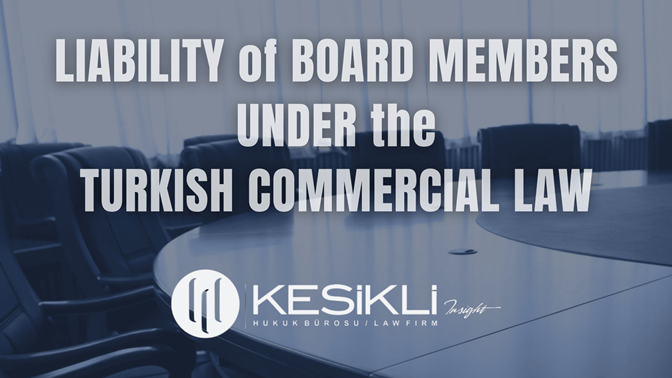Corporate Rescue and Restructuring in Turkey
In the toughness of commercial life, sometimes businesses may fail due to various reasons which are generally, but not necessarily, related with poor management, bad judgement decisions, lack of internal control mechanisms or a turbulent market environment. When a company reaches to such a stage at which insolvency becomes highly probable, if not certain, the directors of a company would, presumably, be keen to take measures which are aimed at turning the company around from the verge of insolvency. As a matter of fact, when the company has lost more than half (but less than two thirds) of its capital and statutory reserves, the directors are obliged to call the general assembly and discuss what can be done to put the company back on track (TCC Art. 376 s.1). When the company has lost more than two thirds of its capital and statutory reserves, again, the directors must call a general assembly meeting and, this time, the general assembly should decide either to (i) confine the capital to one thirds of it or (ii) to inject the lost capital back into the company. Should the general assembly fail to take either of these decisions, then the company will cease to exist (TCC 376 s.2). Additionally, if there are indications creating the suspicion that the company is insolvent, the board of directors should issue an interim balance sheet based on the possible sales value of the company’s assets (TCC 376 s.3). If this interim balance sheet demonstrates that the company is insolvent, then the directors must request the company’s insolvency (TCC 376 s.3).\ When a company faces with such a difficult situation, an intervention would become necessary to avoid ultimate failure of the company and, hopefully, restore the company back to its former healthy state. Since the insolvency law’s ultimate purpose is not only to collect the debts and pay, to the extent possible, the creditors, but also to protect the interests of other constituents (such as employees, general public, economy and so on) which may be best achieved if the firms are kept in operation, similar to other modern bankruptcy laws, Turkish bankruptcy law offers certain remedies through which companies can be rescued from insolvent liquidation.\ This practice note will examine what can be done under Turkish law to manage corporate crisis. It should be borne in mind, however, that the legal remedies of companies which are in financial distress are dependent on the existence of a viable, well-supported, detailed and convincing rescue plan demonstrating how implementation of which make the company solvent again and, also, on the willingness of the creditors to “play along”.\ Firstly, the question of when a company becomes bankrupt will be investigated. Afterwards, this practice note will move on to examine the paths through which a financially distressed company may be saved.
Bankruptcy
\ Under Turkish Insolvency Law, bankruptcy proceedings may be brought against merchants. “Merchant” is a term of art under Turkish commercial law analysis of which would be beyond the scope of this practice note. For the present purposes, it would be sufficient to say that commercial companies (e.g. joint stock companies and limited liability companies) which are the focus of this practice note are, by operation of law, merchants. However, as might be expected, the scope of the term “merchant” is more comprehensive. Therefore, the expression “persons who are subject to bankruptcy” should be understood as including joint stock companies and limited companies and other persons, whether natural or judicial, who are also merchants.\ In order to make a discussion with respect to rescuing companies form bankruptcy, the point at which they become insolvent should be pinned down. Conceptually, there are two methods used to identify whether a company is insolvent. These methods are cash-flow analysis and balance sheet analysis. Under the cash-flow analysis, one looks at whether the company is able to service its debts. The inability to service corporate debts may be caused by temporary liquidity problems, which can easily be overcome by a mezzanine loan, or the reason might be that the company simply lacks the assets by which it can service its debts. In other words, no regard is given to the difference between a company’s assets and its debts. Under balance sheet approach, on the other hand, one looks at whether the company’s assets are enough to cover its debts. If, after such an analysis, it is deduced that the total value of companies’ assets is less than the aggregate of its debts, then it will be concluded that the company is insolvent.\ Turkish insolvency law recognises the former as the general test to identify solvency for all persons who are subject to bankruptcy. For commercial companies, in addition to cash flow analysis, as mentioned above, the first sentence of Art. 179 of the Enforcement and Bankruptcy Code (“EBC”) provides for application of balance sheet analysis. Therefore, if a joint stock company or a limited liability company fails to service its debts as they fall due or its assets are not enough to cover its debts, it would be deduced that the company is insolvent. As a result, the company may be subjected to bankruptcy proceedings which may, if not properly intervened, end up with an insolvent liquidation.\ Although EBC does not put an express obligation to stop trading when insolvency becomes probable, one must bear in mind that negligent bankruptcy is a crime punishable by imprisonment as per Art. 162 of Turkish Criminal Code (“TCrC”). The article defines the negligence element as not showing due diligence and care which would ordinarily be expected from a merchant. In this context, as per Art. 18 s. 2 of Turkish Commercial Code (“TCC”), merchants are obliged to act with diligence in all matters relating to their trade. Although it is not possible to set its exact boundaries, this degree of care is higher than the one which would have been expected from an ordinary person. Therefore, at least when insolvency seems unavoidable, the decision to continue trading would, often times, be regarded as falling short of what is ordinarily expected from a person who is required to act in accordance with the degree of care set out under Art. 18 s. 2 of TCC. Furthermore, if it is shown in the interim balance sheet that the company is insolvent, the directors of the insolvent company must request the company’s insolvency (TCC Art. 376 s.3). In such a circumstance, the board of directors is not granted discretion as to whether to file insolvency.\ Against this background, the directors of a financially distressed company have two choices. They either adopt a wait-and-see strategy (however, depending on the circumstances, this may attract the director’s liability as TCC Art. 369 obliges the directors to promote the benefit of the company by acting in good faith) or act proactive to avoid bankruptcy. Since corporate rescue procedures tend to be more effective if initiated at an early stage, it is advisable that they opt for the second approach as soon as they diagnose the problem in the company. This practice note will now move on to discuss what can be done after corporate crisis arise.
Subordination Agreements
\ The concept of subordination agreements is not a familiar one under Turkish law. This is largely because of the fact that granting beneficial ownership by way of trust is conceptually not possible under Turkish law. Hence, this limits the ways in which subordination can be achieved—e.g. turnover subordination would not be possible. Therefore, subordinations will be achieved by way of contractual subordination under which the junior creditor agrees that it will not claim its debt until the senior creditor is paid in full.\ The subordination may save the company from bankruptcy (although the directors’ obligation to file a bankruptcy application will not be affected) if it can convince those creditors receivables of whom are large enough to cover the deficiency in the difference between the company’s assets and its liabilities to subordinate themselves after the other creditors, then the company may be saved from bankruptcy. In absence of a subordination agreement, unsecured creditors would be paid parri pasu as per the distribution rules set out under Art. 206 of EBC. With such a subordination agreement, the junior creditor waives its right to participate to parri passu distribution. It is submitted that such subordination agreements must be in writing and contain an undertaking to not to launch a claim until the company is solvent again (Tekinalp 12-139).\ TCC Art. 376 contemplates some formalities with respect to such subordination agreements. A court appointed expert will examine the suitability, authenticity and validity of the subordination agreement. If the court appointed expert is not satisfied and, hence, refuses to approve the subordination agreement, the directors’ application to the court to have the subordination agreement scrutinised would be deemed as an insolvency application.
Bankruptcy Deferral
\ Important note: With the decree numbered 669, bankruptcy deferral applications have been suspended during the term of state of emergency which is, at the time of writing, still in place.\ Bankruptcy deferral is a formal, and presumably the most effective, way of corporate rescue provided by the EBC. It is convenient in the sense that less effort, if any, will be spent in convincing the creditors, who may act unreasonably from time to time, that the rescue plan is a viable one and they will get more than what they would have get had they do not permit the company to implement its rescue plan. Instead, such efforts are directed towards a judge who is, generally, free from all of the personal antagonisms which may exist between the parties resulting from the problems in their business. Furthermore, should the court opine in favour of the insolvent company and approve the bankruptcy deferral, then Art. 179/b contemplates a moratorium for a period designated by the court. Bankruptcy deferral is regulated under Arts. 179 – 179/b of EBC. What must be emphasised from these articles is the importance of the existence of a viable, realistic, detailed restructuring and rescue plan depicting how the company will be rescued from its current financial difficulties. The time invested in preparation of such a plan would be time well-spent since the court is not likely to approve a bankruptcy deferral application with a superficial, few-pages-long report.
Formal Bankruptcy Arrangements
\ EBC also allows formal schemes of arrangements to be entered into between the company and its creditors. Formal bankruptcy arrangements are regulated in Arts. 285-309. Schemes of arrangement can be offered before or after the company becomes bankrupt. If it is offered before bankruptcy, then it will prevent the company’s bankruptcy. If the arrangement is offered after the company becomes bankrupt and if the arrangement is accepted and approved, the state of insolvency will cease.\ Similar to the bankruptcy deferral applications, formal bankruptcy arrangements require an arrangement plan. Therefore, what has been said with respect to the restructuring plan which needs to be submitted with respect to bankruptcy deferral applications also apply here. The report should be detailed and professionally prepared in order to be convincing. If the court finds it appropriate, it will give a grace period within which the company may conclude the scheme of arrangement with its creditors. If the arrangement is accepted by creditors representing half of the registered receivables and two thirds of the number of creditors, then it will be concluded that the arrangement is accepted. (Art. 297 EBC). In such a case, after the approval of the court, the arrangement will be binding not only those who consented to it, but also those who objected.
Informal Bankruptcy Arrangements
\ Informal bankruptcy arrangements are always seen to be beneficial for the distressed company. This is understandable since formal insolvency proceedings are liable to trigger defaults under the contracts to which the distressed company is a party, it will damage the company’s reputation in the eyes of its trading partners who would not necessarily become aware of that the company is having financial difficulties, it will definitely result in a devaluation of the company’s credit rating and so on. It is also beneficial for the directors since, under informal bankruptcy arrangements, their management decisions are less likely to be scrutinised.\ It needs to be noted, however, that informal arrangement is a fragile device which demands a high degree of all cooperation. Basically, consent of all creditors would be required to make this work. If one of the creditors is left unsatisfied in the negotiations with respect to informal arrangements, he may perfectly trigger bankruptcy proceedings which would defeat the effectiveness of the informal arrangement. This is essentially due to the fact that such kind of insolvency arrangements are purely contracts between the creditors and the debtor which is subject to the principles of Turkish Code of Obligations (“TCO”). As a result, informal bankruptcy arrangements will not be binding on those creditors who have not consented to it. Therefore, it may be said that the privacy comes in the expense of convenience and supportive provisions of EBC.
Mergers Under Art 139 of Turkish Commercial Code
\ Art. 139 of TCC contemplates “healing merger” for financially distressed companies. It is stipulated that those companies two thirds of capital and contingency funds of which have been lost or those companies which are “insolvent” may merge with another company having sufficient net worth available for free disposal to cover the deficiency or cure the state of insolvency. Documents proving these conditions should be submitted to the commercial court of the place where the headquarters of the acquiring company.\ A detailed analysis of mergers would be beyond the scope of this practice note since mergers, per se, may be the subject matters of a detailed and comprehensive study. Therefore, specialist texts should be referred to for those who would like to acquire more information with respect to such mergers.
Restructuring by way of Agreement
\ Restructuring by way of Agreement is also a way, although not a very popular one due to its hurdles, to avert bankruptcy. Again, a detailed restructuring project will be required to make this work and court approval will be needed. In order court to approve restructuring by way of agreement; (i) the company should act in good faith, (ii) the restructuring project should be negotiated before application to the court, (iii) consent of majority of the creditors who will be affected by the restructuring project should be obtained, (iv) the project should be prepared in accordance with the EBC and the regulation, (v) it should be proven than the amount that the objecting creditors are to get is equal to the amount that they would have get had the insolvent liquidation occurred.
Conclusion
\ This practice note has provided a brief overview of what can be done to rescue financially distressed companies under Turkish law. It must be noted, however, that each matrix of fact would require tailor-made structures. Kesikli Law Firm, with its competent practitioners, is ready to assist you in this quest of turnaround.
Let's Get Connected!



